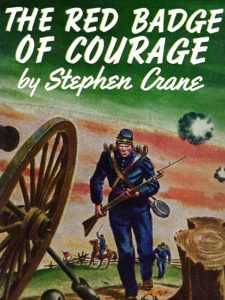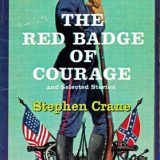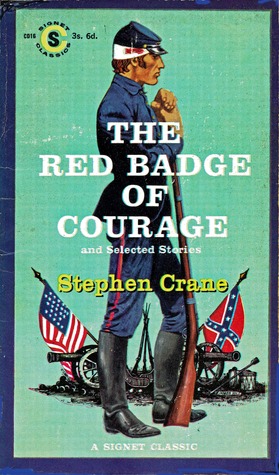The Red Badge of Courage – Stephen Crane – 1895

Reviewed by: Geoffrey Fox gf@geoffreyfox.com www.geoffreyfox.com
Date: 20 January 2003
Labouring in the fiction factory
Continuing my program of reading famous works that I’d been avoiding, I got through Stephen Crane’s The Red Badge of Courage (1895) recently. It was a big disappointment. Why then, asked She Who Must Be Answered, is it so famous? (This is the problem of living with articulate people. They’re never satisfied with an opinion such as “I loved it” or “Ugh!”)
I’m sure there are literary historians who could tell you. I suppose the novel made a big impression because it highlights the gory, ugly details of combat, de-glorifying the heroic gilded myth of America’s greatest conflict. The protagonist panics in his first skirmish and runs for his life, fantasizing various means of desertion. He only accidentally finds himself in battle again, and his mad rush toward the enemy is presented as a kind of delirium rather than sober heroism. All the details of mud and blood and confusion at the battle of Chancellorsville (May 1-3, 1863) came from attentive research, imagined by a writer who had never been to war. (For a clear account of the reception and background of the novel, see this unsigned three-part essay from the University or Virginia.
So I must admit: it is an important book, and my disappointment with it was strictly personal: I didn’t find in it what I had hoped to, which was story-telling technique I could use. It’s overloaded with adjectives, the subjects of many of the sentences are inanimate things or abstractions, and it’s got more atmosphere than story. Not the sort of thing I want to emulate.
In the first volume of his memoirs, Vivir para contarla (2002), Gabriel García Márquez writes (this is my translation): “my library has never been much more than a working tool, where I can consult instantly a chapter of Dostoyevski, or verify a fact about Julius Caesar’s epilepsy or about the mechanism of an automobile carburetor. I even have a manual for committing perfect murders, in case one of my poor characters ever needs one.” He also says of the North American novelists he was reading while writing his first novel, La hojarasca (1955; translated as “Leafstorm”), that he read them with “insatiable curiosity” to discover how they were written. He read them first “right side up, then backwards, and I submitted them to a kind of surgical disemboweling until I uncovered the most deeply hidden mysteries of their structure.”
I think any serious fiction writer reads other fiction he or she admires that way. That was the way I treated García Márquez’s One Hundred Years of Solitude when I had to “disembowel” it for a Monarch Noteclass. Red Badge of Courage doesn’t invite that kind of operation. It’s not complicated enough.















